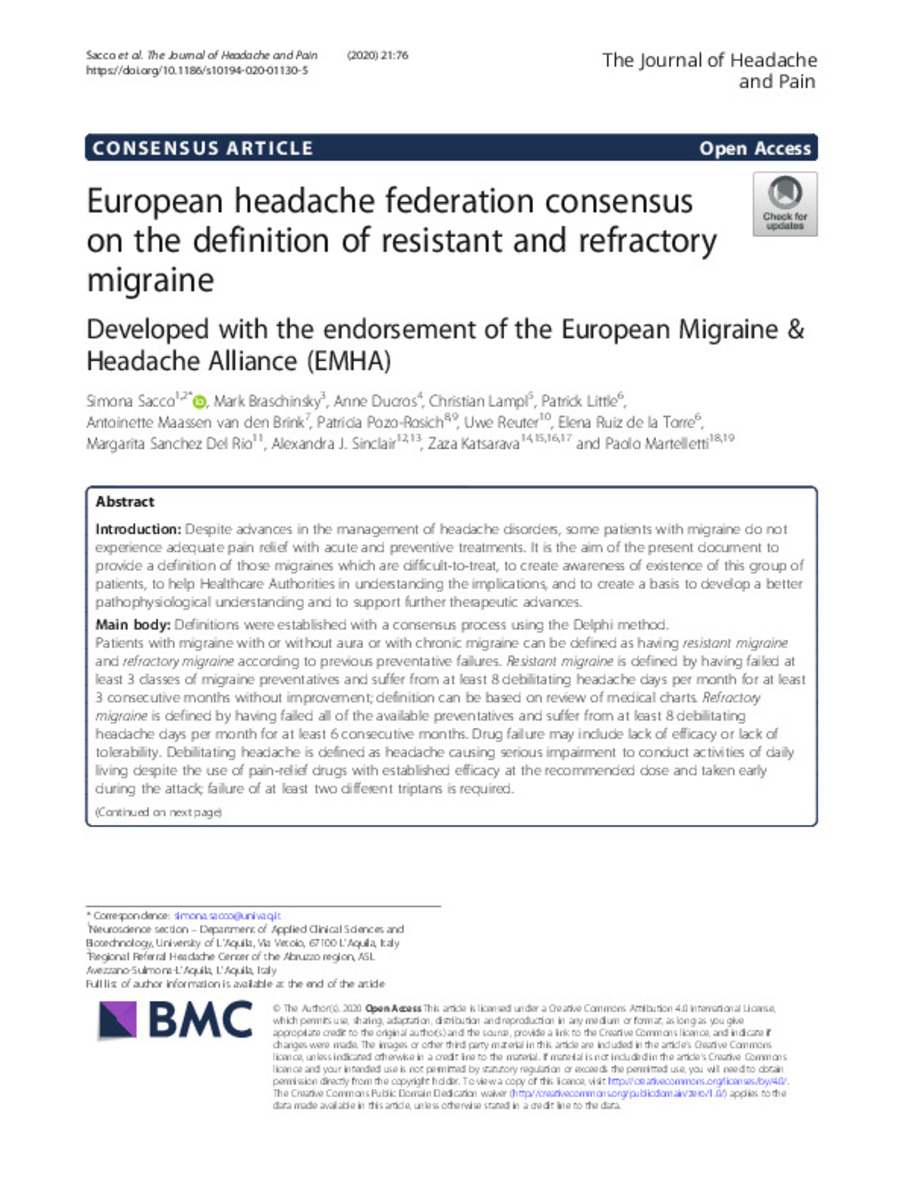Full metadata record
| DC Field | Value | Language |
|---|---|---|
| dc.creator | Sacco, S. (Simona) | - |
| dc.creator | Braschinsky, M. (Mark) | - |
| dc.creator | Ducros, A. (Anne) | - |
| dc.creator | Lampl, C. (Christian) | - |
| dc.creator | Little, P. (Patrick) | - |
| dc.creator | Maassen-van-den-Brink, A. (Antoinette) | - |
| dc.creator | Pozo-Rosich, P. (Patricia) | - |
| dc.creator | Reuter, U. (Uwe) | - |
| dc.creator | Ruiz-de-la-Torre, E. (Elena) | - |
| dc.creator | Sanchez-del-Río, M. (Margarita) | - |
| dc.creator | Sinclair, A. (Alexandra) | - |
| dc.creator | Katsarava, Z. (Zaza) | - |
| dc.creator | Martelletti, P. (Paolo) | - |
| dc.date.accessioned | 2023-05-16T12:12:16Z | - |
| dc.date.available | 2023-05-16T12:12:16Z | - |
| dc.date.issued | 2020 | - |
| dc.identifier.citation | Sacco, S. (Simona); Braschinsky, M. (Mark); Ducros, A. (Anne); et al. "European headache federation consensus on the definition of resistant and refractory migraine". The Journal of Headache and Pain. 21 (76), 2020, | es_ES |
| dc.identifier.issn | 1129-2369 | - |
| dc.identifier.uri | https://hdl.handle.net/10171/66266 | - |
| dc.description.abstract | Introduction: Despite advances in the management of headache disorders, some patients with migraine do not experience adequate pain relief with acute and preventive treatments. It is the aim of the present document to provide a definition of those migraines which are difficult-to-treat, to create awareness of existence of this group of patients, to help Healthcare Authorities in understanding the implications, and to create a basis to develop a better pathophysiological understanding and to support further therapeutic advances. Main body: Definitions were established with a consensus process using the Delphi method. Patients with migraine with or without aura or with chronic migraine can be defined as having resistant migraine and refractory migraine according to previous preventative failures. Resistant migraine is defined by having failed at least 3 classes of migraine preventatives and suffer from at least 8 debilitating headache days per month for at least 3 consecutive months without improvement; definition can be based on review of medical charts. Refractory migraine is defined by having failed all of the available preventatives and suffer from at least 8 debilitating headache days per month for at least 6 consecutive months. Drug failure may include lack of efficacy or lack of tolerability. Debilitating headache is defined as headache causing serious impairment to conduct activities of daily living despite the use of pain-relief drugs with established efficacy at the recommended dose and taken early during the attack; failure of at least two different triptans is required. Conclusions: We hope, that the updated EHF definition will be able to solve the conflicts that have limited the use of definitions which have been put forward in the past. Only with a widely accepted definition, progresses in difficult-to-treat migraine can be achieved. This new definition has also the aim to increase the understanding of the impact of the migraine as a disease with all of its social, legal and healthcare implications. It is the hope of the EHF Expert Consensus Group that the proposed criteria will stimulate further clinical, scientific and social attention to patients who suffer from migraine which is difficult-to-treat. | es_ES |
| dc.description.sponsorship | Publication fees for this publication were covered by the European Headache Federation. | es_ES |
| dc.language.iso | eng | es_ES |
| dc.rights | info:eu-repo/semantics/openAccess | es_ES |
| dc.subject | Migraine | es_ES |
| dc.subject | Chronic migraine | es_ES |
| dc.subject | Resistant migraine | es_ES |
| dc.subject | Refractory migraine | es_ES |
| dc.subject | Intractable migraine | es_ES |
| dc.title | European headache federation consensus on the definition of resistant and refractory migraine | es_ES |
| dc.title.alternative | Developed with the endorsement of the European Migraine & Headache Alliance (EMHA) | es_ES |
| dc.type | info:eu-repo/semantics/article | es_ES |
| dc.description.note | This article is licensed under a Creative Commons Attribution 4.0 International License, which permits use, sharing, adaptation, distribution and reproduction in any medium or format, as long as you give appropriate credit to the original author(s) and the source, provide a link to the Creative Commons licence, and indicate if changes were made. The images or other third party material in this article are included in the article's Creative Commons licence, unless indicated otherwise in a credit line to the material. If material is not included in the article's Creative Commons licence and your intended use is not permitted by statutory regulation or exceeds the permitted use, you will need to obtain permission directly from the copyright holder. To view a copy of this licence, visit http://creativecommons.org/licenses/by/4.0/. The Creative Commons Public Domain Dedication waiver (http://creativecommons.org/publicdomain/zero/1.0/) applies to the data made available in this article, unless otherwise stated in a credit line to the data. | es_ES |
| dc.editorial.note | Springer Nature remains neutral with regard to jurisdictional claims in published maps and institutional affiliations. | es_ES |
| dc.identifier.doi | 10.1186/s10194-020-01130-5 | - |
| dadun.citation.number | 76 | es_ES |
| dadun.citation.publicationName | The Journal of Headache and Pain | es_ES |
| dadun.citation.volume | 21 | es_ES |
Files in This Item:
Statistics and impact
Items in Dadun are protected by copyright, with all rights reserved, unless otherwise indicated.






